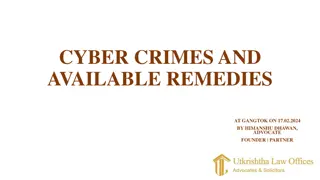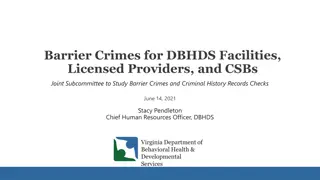Understanding Burglary Offences and Acts Reus in Property Crimes
Burglary is a serious property offence outlined in the Theft Act 1968, with distinct elements and penalties. The actus reus of burglary involves entry as a trespasser into a building with intent to steal, cause harm, or damage property. Differentiating between the offenses under section 9(1)(a) and 9(1)(b) is crucial, as they entail varying intentions and actions. Court interpretations, such as in landmark cases like R v. Collins and R v. Brown, continue to shape the legal understanding of burglary.
Download Presentation

Please find below an Image/Link to download the presentation.
The content on the website is provided AS IS for your information and personal use only. It may not be sold, licensed, or shared on other websites without obtaining consent from the author. Download presentation by click this link. If you encounter any issues during the download, it is possible that the publisher has removed the file from their server.
E N D
Presentation Transcript
PROPERTY OFFENCES, INCLUDING THEFT AND ROBBERY BURGLARY
Burglary The offence of Burglary is set out in section 9 of the Theft Act 1968. There are in fact two offences of burglary under s.9(1)(a) and s.9(1)(b). There is also an offence under s.10 of theTheftAct 1968 of aggravated burglary. The maximum sentence on conviction for burglary is 14 years if the burglar has entered a dwelling or maximum of 10 years if the burglar has entered any other building. Aggravated burglary carries a maximum of life imprisonment. Let s have a look at the different types of burglary.
Burglary under s.9(1)(a) A person is guilty of burglary under s.9(1)(a) if he enters a building, or any part of a building, as a trespasser, with intent to either: steal anything in the building, inflict GBH on any person in the building or doing unlawful damage to the building or anything in it.
Burglary under s.9(1)(b) A person is guilty of burglary under s.9(1)(b) if, having entered a building or part of a building as a trespasser, he steals, attempts to steal anything in the building or inflict or attempts to inflict GBH on any person therein.
Burglary There are common elements to the offences. There has to be: entry a building or part of a building a trespasser The main difference of the two offences of burglary is that under s.9(1)(a) the intention must be formed by the defendant at the time of entry whereas under s.9(1)(b) the intent to commit the ulterior offence can come later. What he intends on entry is not relevant. Also (a) covers unlawful damage whereas (b) does not.
Actus reusof burglary The elements that make up the actus reusof the offence burglary are common to both subsections. They are: Entry As a trespasser A building or part of a building Let s look at some of these in turn:
Entry Not defined in statute therefore for the courts to interpret and decide. Case law has allowed the law in this area to evolve. The first case on this definition was: R v Collins (1973) where there had to be an effective and substantial entry . The next case on the matter was R v Brown (1985) where the definition was changed to just mean an effective entry thereby removing the requirement for a substantial entry . However in Ryan (1996) the requirement of an effective entry was not followed.
Building or part of a building This is given a wide definition in the Theft Act 1968 and includes e.g. caravans and houseboats. However, building is not defined. There are some things that would obviously be regarded as a building such as houses, flats, factories, offices etc. Also included are sheds and outbuildings. But what about more temporary structures that have been utilized for storage or work? E.g. portacabinor container? There have been a couple of cases on the issue: B and S v Leathley (1979) where a freezer container connected to the electric supply was held to be a building. Norfolk Constabulary v Seeking and Gould (1986) where a lorry trailer connected to the electric supply but with wheels was not considered to be a building.
Part of a building Covers situations where a defendant is in a part of a building that they do not have permission to be in. He would therefore be a trespasser in that part. E.g. case of Walkington (1979). In this case the defendant was permitted to be in the shop but not in the counter area where he was a trespasser.
As a trespasser This relates to permission to enter. If a defendant has permission to enter then he is not a trespasser as demonstrated in Collins (1972). It must be shown that the defendant was aware he was trespassing or that he was subjectively reckless in doing so. It might be that a person has permission to enter but goes beyond that permission. Smith and Jones (1976). This covers a range of situations where a person stays beyond their permission (e.g. ticket to enter an art show but stays after closing and steals a sculpture).
Mens Rea for Burglary This consists of two elements: The defendant must know they are a trespasser or be subjectively reckless as to whether they are trespassing AND The S.9(1)(a) offence requires intention to commit one of the ulterior offences. For the s.9(1)(b) offence the requisite mensrea of the ulterior offence must be present.



![Prevention and Combating of Hate Crimes and Hate Speech Bill [B.9B.2018]](/thumb/60513/prevention-and-combating-of-hate-crimes-and-hate-speech-bill-b-9b-2018.jpg)



















